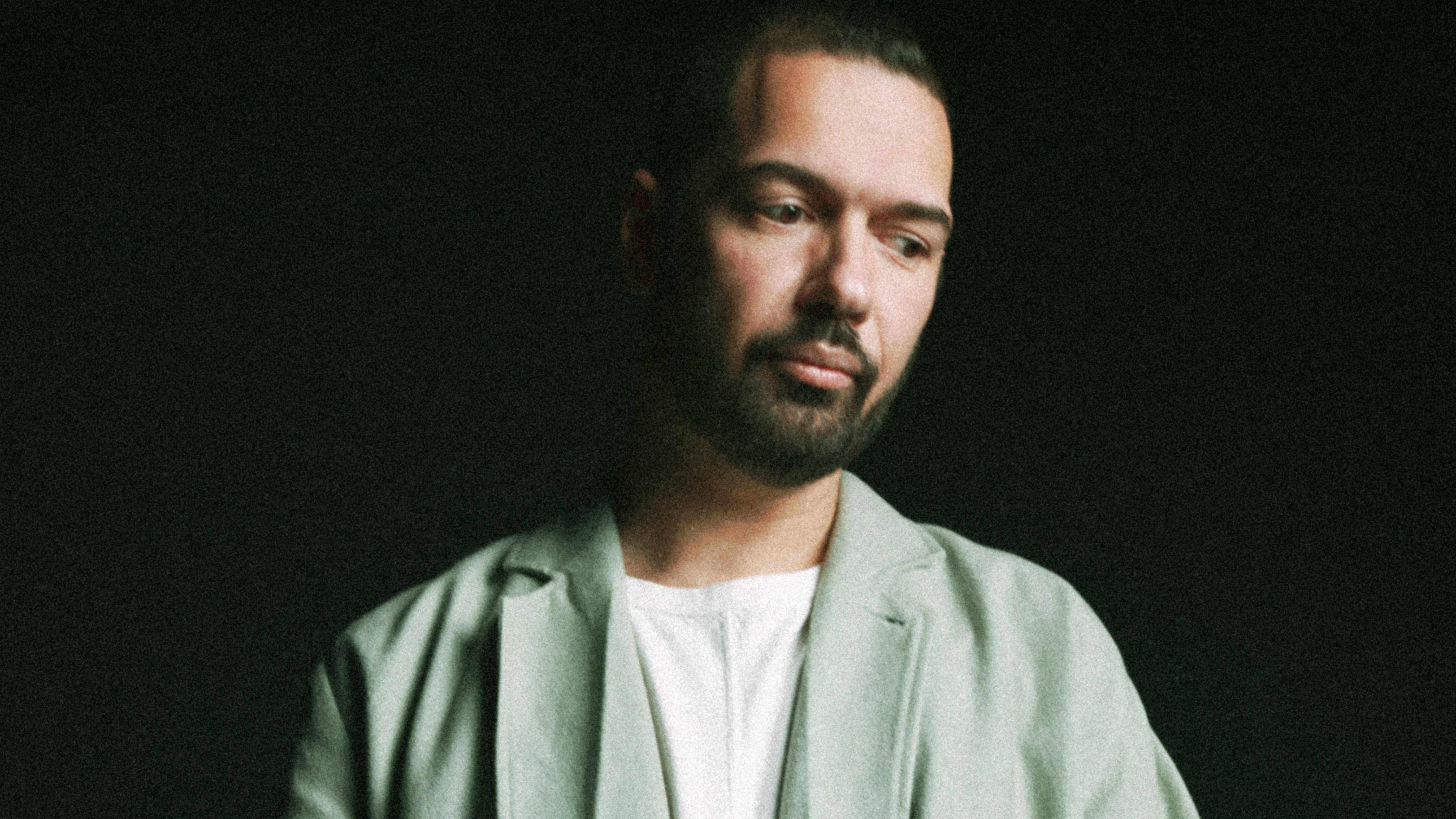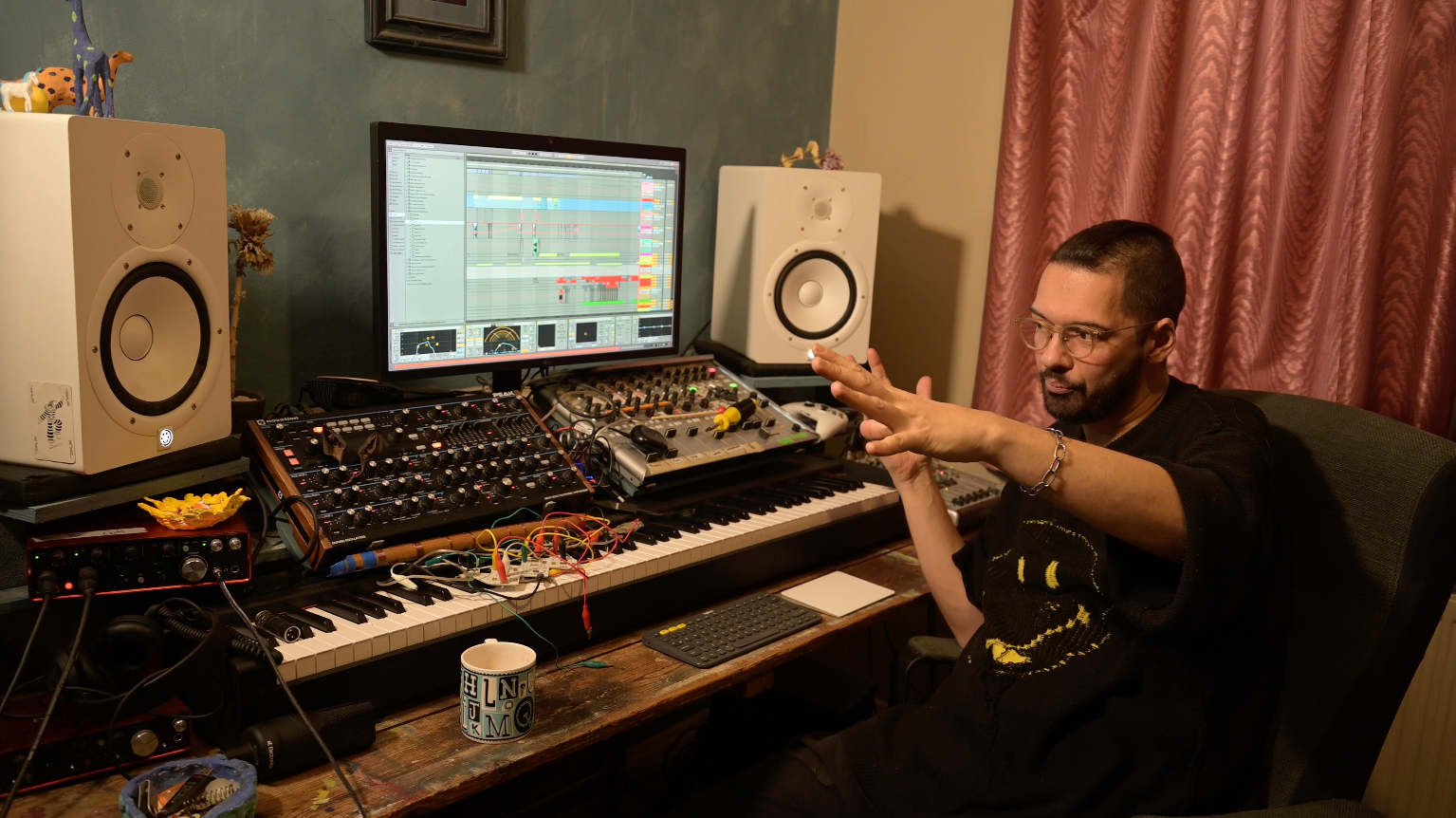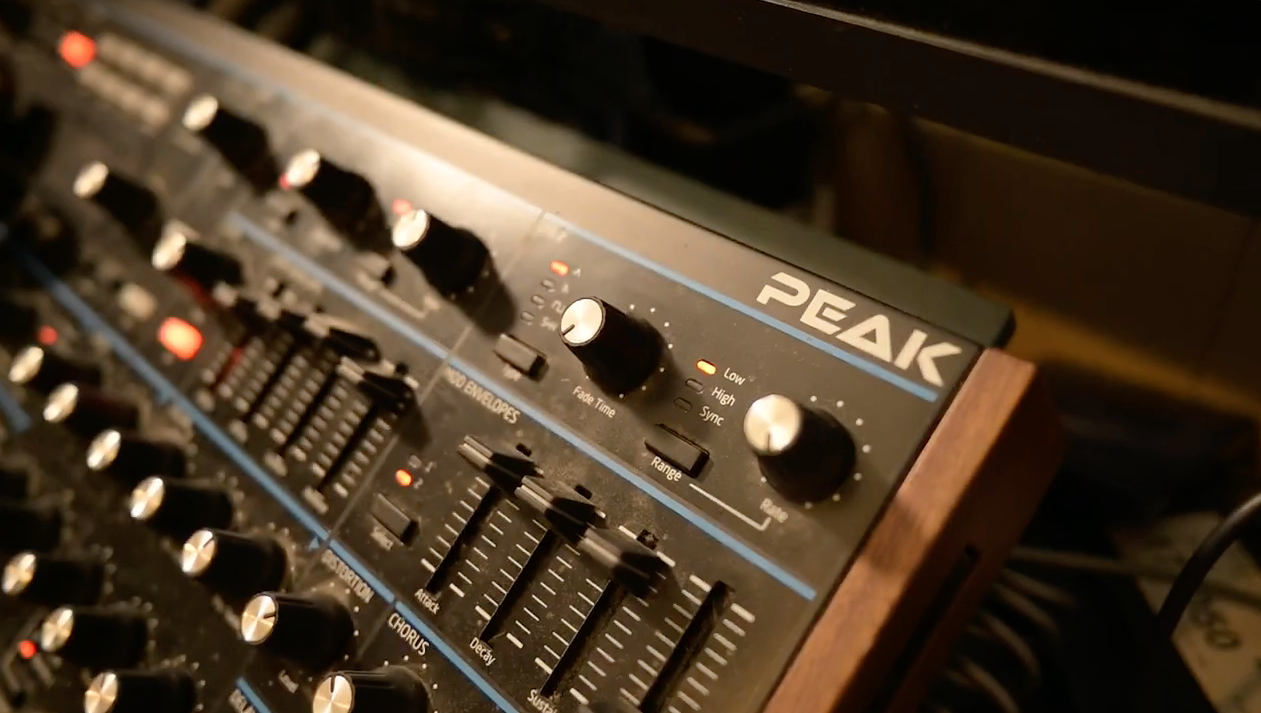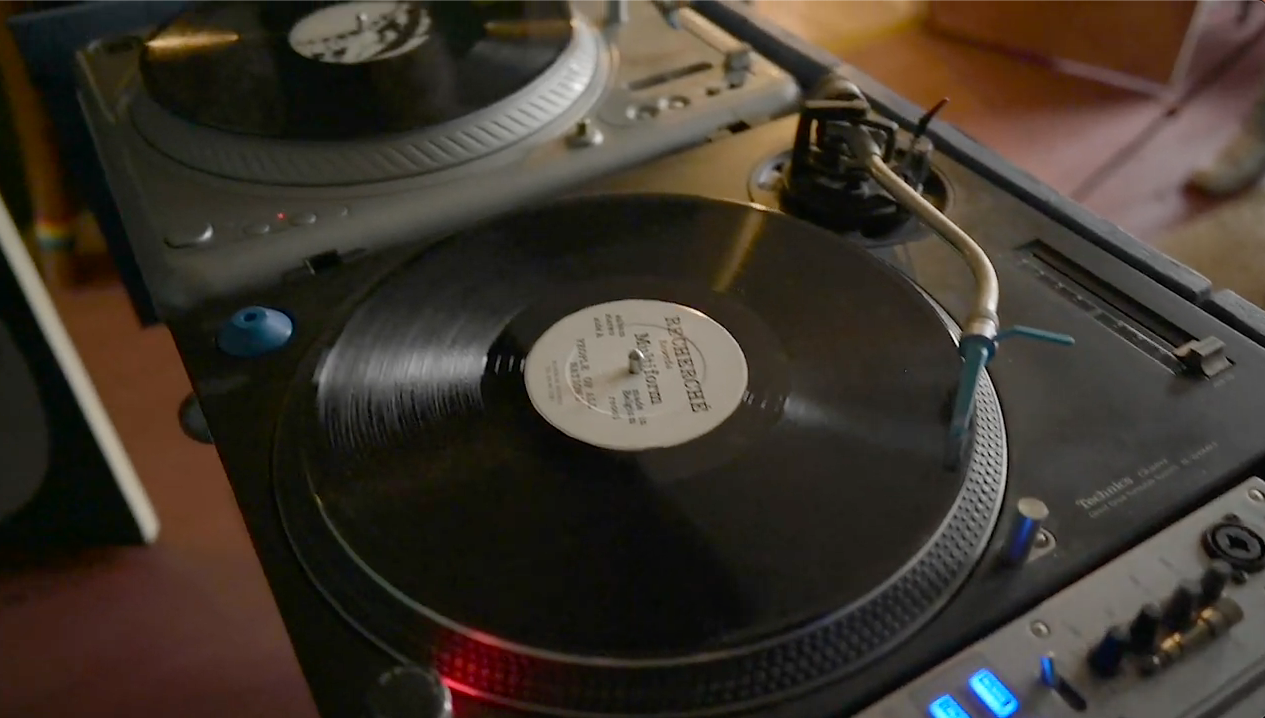"I have a very emotional relationship with my machines”: Djrum on how a catastrophic technological failure led to one of 2025’s best electronic albums
The UK producer on finding inspiration in the piano, his studio tools, and the techniques behind his unique DJ sets

UK producer Djrum – aka Felix Manuel – is something of a word-of-mouth phenomenon in the world of underground dance music.
His unique, head-spinning DJ sets, which see him cutting and scratching techno, jungle and hip-hop across three vinyl turntables, are the sort of unique sonic experiences you rush home to tell your friends about.
Equally noteworthy, however, is Djrum’s production work. Across releases for labels including R&S and Fabric offshoot Houndstooth, Manuel has built a catalogue of tracks that mash up genres from jungle to glitch and dubstep, whilst throwing in elements of acoustic jazz, neo-classical piano and old school rave.
Manuel’s new album, Under Tangled Silence, is undoubtedly his most impressive release yet. Bouncing between delicate piano tracks and skittish IDM, the record feels like a culmination of all the influences Manuel has incorporated into his career to-date.
The album has been in the works longer than you might expect - annd almost didn’t happen. Some of the original ideas that have ended up on Under Tangled Silence were created more than five years ago, prior to the release of Manuel’s previous album, Portrait With Firewood.

With the project almost complete though, a catastrophic technological failure set Manuel back almost to square one.
“I got to a point in 2020 where I felt like the album was almost finished,” he explains, when we visit him at his home studio in Oxford. “I had quite a lot of ideas almost done, and then I had a really major computer failure. It was a power surge. It basically melted my laptop.”
Want all the hottest music and gear news, reviews, deals, features and more, direct to your inbox? Sign up here.
Despite attempts to recover the work, most of the projects and recordings were irretrievable.
“I lost basically all of the work I'd done through the lockdowns of 2020,” he says. “I remember at the time, everyone was saying, ‘Oh, well at least as a creative you're getting loads of time to work on your personal projects’. And yeah, for me, sure, but I lost it all.”
Manuel admits that the loss of such a substantial amount of work inspired a period of depression, and it was a struggle to begin creating again. Despite this though, not every idea from the original project was lost to the ether.
“Some things were just lost altogether,” he explains. “But I was able to recreate or at least reuse many of the ideas, to create something new and probably better.
“I also had some sound files. I lost most of the session files, but because part of my process involves creating mix downs of my work-in-progress to listen to on headphones, I had sections of tracks that were finished or half finished.”

These sound files appear throughout Under Tangled Silence, often audibly corrupted and glitchy. In fact, the aborted creation of the original record ended up providing one of the key inspirational themes for the album, which is inspired in part by the fragility of our relationship with technology.
“I think there's a relationship between us and our machines that is quite a human one, actually,” Manuel says. “It's quite a fragile and emotional one. I have a very emotional relationship with my machines anyway, and I feel like I’m bringing that story into the album.”
Beyond this, one of the most distinctive elements of the album, particularly in comparison with previous Djrum records, is the prominence of Manuel’s piano playing. The piano provides something of a backbone to the record, and many of the tracks – even in the more electronic moments – started life as piano sketches.
“It's quite a nice thing to just sit at the piano and figure things out,” Manuel explains. “Playing the piano is a part of my life. I play the piano to calm down, to just to entertain myself.”
In a similar fashion to how warped and edited lines of flute playing provided the basis for last year’s Meaning’s Edge EP, much of the playing on Under Tangled Silence comes from improvised sketches and loops that Manuel later edited and manipulated .
“My piano is always mic’d up so I can record pretty quickly,” he explains. “This often happens, where I’lI just stumble across an idea whilst I'm improvising, I just sit at the piano and doodle, and then something comes out of it.”
Initially though, Manuel admits that he was hesitant about making the piano such a prominent part of the album’s aesthetic, largely due to a lack of confidence in his own abilities.
“I'm not on the level of my piano heroes – not even nearly,” he explains. “I feel weird putting out a solo piano track. I don't feel worthy. However, when I put a few little electronic elements into it, that helped me feel a little bit more like, ‘Okay, I am bringing something to this.’”
The tracks in question see Manuel accentuating delicate piano playing with subtle electronic ambiences and shifting reverb and delay.
“I feel like as musicians we’re here to contribute, that's what we're here to do,” he continues. “All musicians in the world, in the history of time, we've all been collaborating on this one project called ‘music’. If I put some generic piano lullabies out into the world, it's not a great contribution, because there's plenty of that already existing. The more original what you're doing is, the more of a contribution you’re making, and the more you're actually adding. I'm always very aware of that.”
In the studio
Despite the prominence of the piano, Under Tangled Silence is still very much defined by the detailed electronic sound design and complex rhythmic programming that are a signature of Djrum’s sound. As Manuel demonstrated to us when he broke down the making of last year’s Frekm Pt.2, that sonic signature is built from a largely in-the-box workflow.
“My general setup is all focused around Ableton,” he explains. “I think the built-in effects in Ableton are really good and you can do mostly everything with what's there. I do use some iZotope and FabFilter stuff. I want a better reverb than the Ableton built in one.”
Manuel’s studio setup itself is pretty minimal. The album was created in his home studio, centred around a somewhat aging Macbook hooked up to a simple MIDI keyboard. The studio does have a single physical synthesizer, but its role in Manuel’s creative process is fairly minimal.
“I’ve got one hardware synth, the Novation Peak, which is really cool,” he says. “I got it because I felt like I should give it a go, as I'd never really used hardware before. It took me a long time to be comfortable using synths at all. When I first started using them, I wasn't very good at it and made sounds that were not great.
“For ages I couldn't stand the idea of using presets,” he continues. “I find it very frustrating to not know how a sound is made. I would start using a preset, and I would want to change something about it, but then with a preset, you then have to figure out, like, what's this all doing? Why is it making that sound? I found that so frustrating.”

The minimal setup of Manuel’s studio largely comes down to a desire to truly master each instrument before moving on to another one.
“My approach to synths is very much, like, one at a time,” he explains. “Get to really know a synth before you get another one. I use very few. I use Massive and I like Arturia Pigments, Serum, that's kind of it.
“Then I got this hardware one, but I don't use it much. It's cool to jam and twiddle knobs but if I'm making a bassline or a melodic thing, I want to have it in the session and be able to tweak it and change it. That doesn't really lend itself to integrating hardware. So the Novation is actually barely on this latest album.”
Sonically, Under Tangled Silence strikes a fine balance between electronic textures and more earthy, natural sounds. Alongside the piano that runs through the album, warped cello recordings provide a lot of the naturalistic feel.
“The other part of the process is recording acoustic sounds,” Manuel says. “I work with a cello player, Zosia, and the way we work together is, I will have a starting point idea for a track, and Zosia will come and improvise over the top. Then I take those improvisations and use them as samples. I manipulate them and change them to create new things out of them.”

Although a few unedited cello lines feature throughout the album, often Manuel uses these recordings as source material to twist into more abstract shapes.
“Mostly I work with the mangled up stuff,” he explains. “Sometimes it forces you to come up with weird ideas. I’ll take a recording and I'll pitch it up and really screw it to the point where I've played tracks to the people and they've said, ‘oh, your flute playing is wonderful’ and it’s actually the cello.”
Key to the album’s creation was a conscious balancing act between these elements in Manuel’s sound. Between the acoustic and synthesized textures, but also between elements that reference the history of dance music, and sounds designed to push things forward.
“What I'm trying to achieve is a balance in the middle,” he explains. “I want modernity and I want history. I want to feel timeless, but I also want to feel futuristic. I want to reference medieval music, but I also want to reference ‘90s rave, and music from more recent times as well. I want it to feel relevant to today.”
At the more club-focused end of the spectrum, Djrum’s music often incorporates classic sliced drum breaks and throbbing basslines that nod to ‘90s jungle and ‘00s dubstep.
“I could go too far and it could start to sound retro,” he says. “If that happens then I'm like, ‘Okay, I need something really contemporary in there’.”
DJing vs production
Aside from his recorded output, Manuel’s DJ sets have helped set him apart from the UK’s current electronic music scene. His distinctive style sees him playing all-vinyl, mixed across three turntables, often in a rough and abrupt way.
It’s a unique approach that was showcased in his recent BBC Essential Mix, which sees Manuel drop more than 60 tracks over two hours, deploying the likes of Autechre and Aphex Twin alongside Pusha T and Sister Nancy.
“When I started out DJing, I was into hip-hop and drum & bass and jazz and funk and that kind of stuff,” he explains of the roots of his approach. “It wasn't really a question of using digital or vinyl, it was just vinyl.
“I feel like now, vinyl is kind of my thing. There's mounting pressure to ditch vinyl and go digital. There's more and more reasons to move to digital. But I started out with this, and I've made it my thing. I feel like I would lose something if I ditched it for digital.”

It’s taken a while for Manuel to reach this point as a DJ. His hip-hop informed approach wasn’t initially a natural fit for the electronic music club nights he often found himself DJing at and the varied styles of music he wanted to play.
“I started out with hip-hop and then I came to dance music,” he says. “When I got into deeper sounds, like dub techno and Berlin influenced music, I was finding that my approach to DJing – really chopped up scratching, kind of rough around the edges – didn't really fit with that world of slick DJing. It took me a long time to then bring those rougher elements back into my DJing.”
As well as being a challenge for Manuel himself, his unconventional approach was at times a tough sell for club promoters too.
“It's taken getting to the point where I'm headlining and people come to see what I do, that I've been able to come out of my shell and bring all of the elements of what make me me,” he relates. “Some of those elements are really contradictory, that really smooth techno stuff with rough jungle, where you're cutting and scratching. It’s about finding a way to bring these different styles together.”
In our video interview, which you can watch above or on our MusicRadar Tech Youtube channel, Manuel explains more about the creative approach behind Under Tangled Silence, and the evolving relationship between his DJing and productions.
I'm the Managing Editor of Music Technology at MusicRadar and former Editor-in-Chief of Future Music, Computer Music and Electronic Musician. I've been messing around with music tech in various forms for over two decades. I've also spent the last 10 years forgetting how to play guitar. Find me in the chillout room at raves complaining that it's past my bedtime.
You must confirm your public display name before commenting
Please logout and then login again, you will then be prompted to enter your display name.
